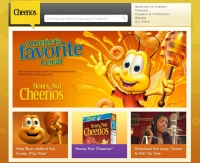AdverGaming
Advergaming is sometimes looked at as serious gaming because it has strong educational or training purposes rather than solely entertainment purposes.[1] Serious ethical implications are intertwined with advergaming, including childhood obesity and peer pressure.
Contents
Background
An average male, ages 18 to 34, spends 15 percent of his time playing video games. The amount of time people spend playing games presents advertising opportunities.[2] Recent polls show that 36% of game players have acted on an advertisement they saw while playing a video game.[2] Of game players surveyed, "11 percent of gamers said they purchased a brand advertised in a game; 19 percent said they talked about a product after seeing it in a game ad; 10 percent said they recommended the product to friends; and 11 percent said they looked up more information on the brand seen."[2] Experts estimate that, by 2011, global spending for advertising space in video games will reach one billion dollars.[2] Advertisers have recognized that many people are playing games and by advertising in games they are likely to get more people to buy their products. Advertisers have recognized that many people are playing videogames and advertising in games motivates people to buy the products displayed.
Types of Advergaming
Above The Line (ATL) Advergaming
Above the line advergaming includes promotional software hoping that potential customers will be attracted by the game, become more product aware, and and will spend more time playing the game.
ATL advergaming are often all about featuring the company’s product. Some are occasionally redrafted arcade classics or may be originally programmed for the company.[3]
Some examples of ATL advergaming include games presented on product websites. The fast food chain, Burger King, released a series of titles for the gaming system XBOX 360, aimed at promoting many of their meals. One in particular, Sneak King, involved the player controlling The King (the BK mascot), and delivering BK food to hungry people.
Below The Line (BTL) Advergaming
Below the line advergaming includes traditional, in-game advertising and recruitment tools. The subjects that are advertised for this type of advergaming may be for commercial, political, or educational purposes. For this technique of advertising within the game, advertisements like billboards or fliers ,and especially product placement are used with the interplay between the player. These elements permit for a great degree of virtual advertisement.
In game BTL advergaming can potentially lower costs that the makers of the game experience, which therefore reduces the cost of the game for the customers. The challenge here is to find the perfect balance of the amount of advertising so that the gamers do not gain a sense of irritation from the advertising.
Through The Line (TTL) Advergaming
Through The Line Advergaming is the least common method of advergaming. Examples of TTL advergaming include “link-chases” and viral marketing. Through the line advergaming tries to provoke the player to visit websites that typically contain below the line advergaming with the use of URL hyperlinks which are with in the game itself. The strategy is to get the player to visit these URL’s differ from game to game. Websites that use TTL advergaming often lead players on to other links which lead to more links and so on and thus warranting the name "link-chases."[4] Games such as "Enter the Matrix", "I Love Bees," and "Lost Experience", have URLs that make up a part of the backgrounds of the games such that certain plot details that can only be learned by following the link that is provided in the game. The knowledge of such plot details are normally not required to complete the game, but adds to the experience of the game with a fuller story for fans.
Advergaming Businesses
"Gamewok is an online advergaming platform available to brand owners, interactive marketing specialists, media planners and digital agencies. GameWok.com offers easy-to-use solutions for all advergaming needs, while maintaining entertainment value and timely delivery for brand launches and campaigns."[5] Gamewok does not only have a market of advertising in gaming environments, but also a market for advergaming itself. Gamewok is advertised as a user friendly 4 step process and clients have access to experienced game developers, programmers, and customer service.[5]
Creating Successful Advergaming
Developing advergames that are really successful can be quite difficult. There are games that have to balance between being really fun and having effect advertising in them. For example, if the game is too fun and the players do not notice any of the advertising then the advertising company has wasted their time, but if all the players notice is advertising then they will fell put off by the game.[6]
One example of a successful advergame was the 1996 game Chex Quest. Chex Quest was a total revision of one of the Doom games and was the first video game ever included as a prize in cereal boxes. Chex Quest was popular enough to not only acquire a cult following, but to also have two full sequels.[7]
Uses of Advergaming
Advergaming can include the following:
- Food Brands
- Toys
- Companies
- Clothing Lines
- Stores
- Politics/Campaigning
- Restaurants
Effects of Advergaming
In 2007, Mallinckrodt and Mizerski wanted to see the effects of advergaming and conducted an experiment involving an advergame about cereal. They had children play the game and recorded their preferences in food afterwards. They noticed that the children preferred the cereal that was advertised in the game.[8]
Ethics of Advergaming
Advertisement vs. Content
An ethical issue that comes with the practice of advertising is the differentiation between content and advertising. As advergaming is becoming more prevalent, it is becoming harder to distinguish between video game content and advertising. On the television, distinguishing between programs and commercials is fairly easy, but as advertising becomes more integrated into game play, this is not the case. When consumers cannot recognize that they are being advertised to, they are not necessarily critical of what they are being presented.
Role in Childhood Obesity
Many of the main advertisers that utilize the practice of advergaming do so in order to target the younger generation. Among these advertisers are major food brands such as Kraft and McDonalds that use advergaming in the form of food-themed games to draw kids to their site, and keep them coming back [9]. Though advergaming cannot be blamed for the childhood obesity epidemic America has seen recently, it does play a role. According to a poll of 3,000 children conducted by Intuitive Media, 43% of the respondents answered that they were more likely to eat a food or snack if they saw it online or in a game. Furthermore, 61% answered that they visit food websites [10]. Advergaming's influence on children has facilitated the rise in childhood obesity and is a practice that should be regulated carefully.
Presentation of Image
Much of advergaming works like normal advertising does because there are presented images to the players. For example, some products may be advertised in games such as Call of Duty or Warcraft in order to say that people who are tough use this products. Other games may advertise products by subliminally applying the labels of "cool" or "popular" to people in the game, therefore implying that if the player desires these characteristics, they should buy this product. It acts as a form of peer pressure.
Data Privacy and Consent
Advergaming is a great source of data for companies which utilize it. They can figure out where people are playing their game, if users are interested in their products, what demographic the user is in, and so much more. It also utilizes the data that is collected from us from other data sites to target certain users with the games. Like most data sharing sites, it is important to note that there are ethical concerns on exactly what data is being gathered and who is it being shared with. Hinted at in Iris Recognition, consent to the use and access of our data is something that is important. Sites like Twitter and 23andMe, make sure that they have consent, in some sort of form, to share our data with other agencies or at least making us aware of the sharing. Due to most advergaming being pop-ups or during the loading menus of other content, we are not directly consenting to playing the games. Gary T. Marx states that this is just the new age of surveillance we live in, one where is gathered and shared without consent[11]. It is hard not feel a sense of unease when you are just playing a meaningless, simple video game, but in reality it is so important for their advertising and increasing revenue streams.
See Also
External Links
References
- ↑ Ernest Adams (2009-07-09). "Sorting Out the Genre Muddle". Gamasutra. Retrieved on 23 May 2009.
- ↑ 2.0 2.1 2.2 2.3 Wedekind, Jennifer. "Advergaming." Multinational Monitor 26.3 (2008): 56. Print. Retrieved on 23 May 2009.
- ↑ ""What Kind of Advergame is it?" - Four Categories That Make Actual Sense.". Sneaky Games. April 10, 2009. Retrieved on 03 July 2010.
- ↑ ""Advergames, Viral games, and online flash games design" Front Network". Frontnetwork.net. Retrieved on 23 June 2010.
- ↑ 5.0 5.1 Anonymous. "GameWok.com Delivers Advergaming Solutions." Marketing Weekly News [Atlanta] 10 Oct. 2009: 98. Retrieved on 23 June 2010.
- ↑ Radd, David. "The Secrets of Advergaming." 23 May 2007. Retrieved on 23 June 2010.
- ↑ Wikipedia. "Chex Quest." Retrieved on 23 June 2010.
- ↑ Cicchirillo, Vincent. Ethical Issues in Communication Professions: New Agendas in Communication 15 August 2013
- ↑ Potter, Elicia. "Advergaming and Ethics." Retrieved on 23 June 2010.
- ↑ BBC News. "Fast food brands hit kids online." 18 July 2007. Retrieved on 23 June 2010.
- ↑ Marx, Gary T. “What's New About the ‘New Surveillance’? Classifying for Change and Continuity.” Surveillance & Society, vol. 1, no. 1, 2002, pp. 9–29., doi:10.24908/ss.v1i1.3391.




